sensor RENAULT KANGOO 2017 X61 / 2.G Owners Manual
[x] Cancel search | Manufacturer: RENAULT, Model Year: 2017, Model line: KANGOO, Model: RENAULT KANGOO 2017 X61 / 2.GPages: 260, PDF Size: 5.68 MB
Page 36 of 260
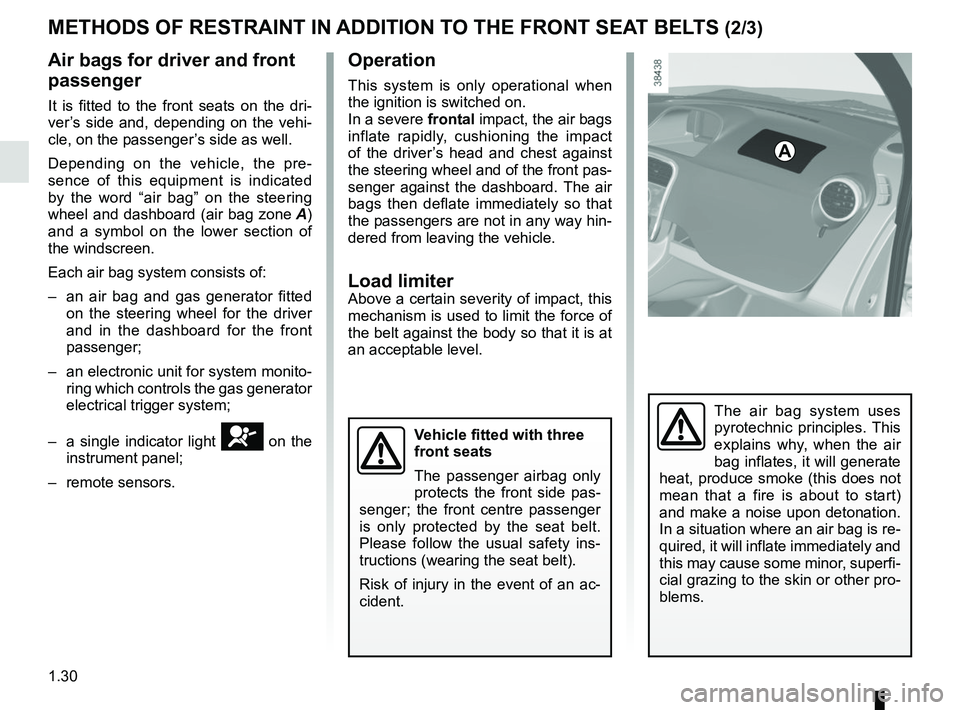
1.30
METHODS OF RESTRAINT IN ADDITION TO THE FRONT SEAT BELTS (2/3)
Air bags for driver and front
passenger
It is fitted to the front seats on the dri-
ver’s side and, depending on the vehi-
cle, on the passenger’s side as well.
Depending on the vehicle, the pre-
sence of this equipment is indicated
by the word “air bag” on the steering
wheel and dashboard (air bag zone A)
and a symbol on the lower section of
the windscreen.
Each air bag system consists of:
– an air bag and gas generator fitted on the steering wheel for the driver
and in the dashboard for the front
passenger;
– an electronic unit for system monito- ring which controls the gas generator
electrical trigger system;
– a single indicator light
å on the
instrument panel;
– remote sensors.
A
Operation
This system is only operational when
the ignition is switched on.
In a severe frontal impact, the air bags inflate rapidly, cushioning the impact
of the driver’s head and chest against
the steering wheel and of the front pas-
senger against the dashboard. The air
bags then deflate immediately so that
the passengers are not in any way hin-
dered from leaving the vehicle.
Load limiterAbove a certain severity of impact, this
mechanism is used to limit the force of
the belt against the body so that it is at
an acceptable level.
The air bag system uses
pyrotechnic principles. This
explains why, when the air
bag inflates, it will generate
heat, produce smoke (this does not
mean that a fire is about to start)
and make a noise upon detonation.
In a situation where an air bag is re-
quired, it will inflate immediately and
this may cause some minor, superfi-
cial grazing to the skin or other pro-
blems.
Vehicle fitted with three
front seats
The passenger airbag only
protects the front side pas-
senger; the front centre passenger
is only protected by the seat belt.
Please follow the usual safety ins-
tructions (wearing the seat belt).
Risk of injury in the event of an ac-
cident.
Page 108 of 260
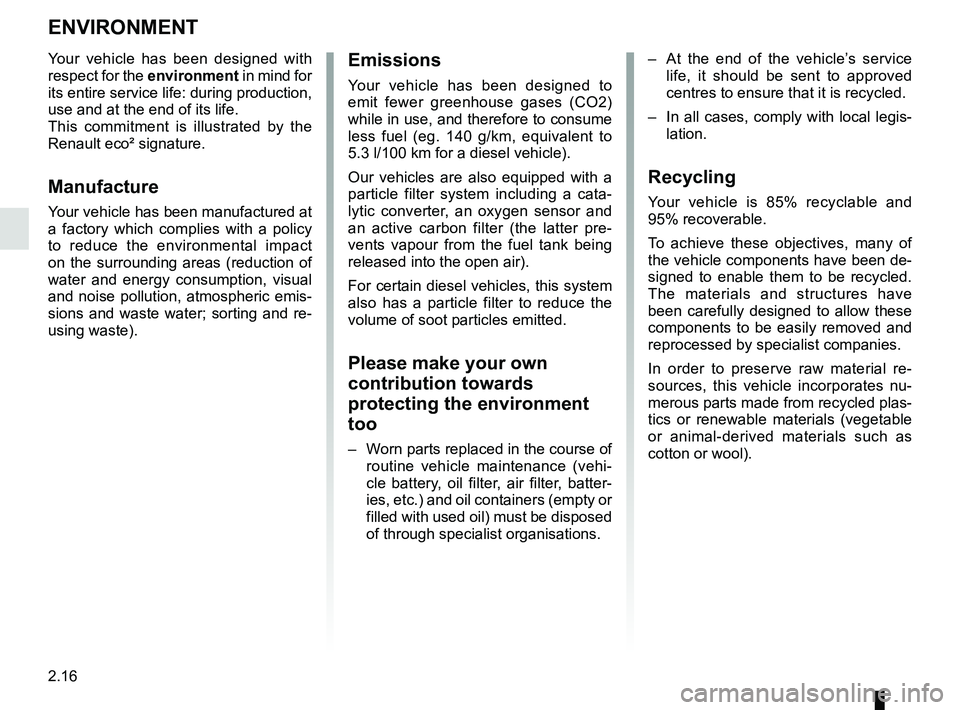
2.16
ENVIRONMENT
Emissions
Your vehicle has been designed to
emit fewer greenhouse gases (CO2)
while in use, and therefore to consume
less fuel (eg. 140 g/km, equivalent to
5.3 l/100 km for a diesel vehicle).
Our vehicles are also equipped with a
particle filter system including a cata-
lytic converter, an oxygen sensor and
an active carbon filter (the latter pre-
vents vapour from the fuel tank being
released into the open air).
For certain diesel vehicles, this system
also has a particle filter to reduce the
volume of soot particles emitted.
Please make your own
contribution towards
protecting the environment
too
– Worn parts replaced in the course of routine vehicle maintenance (vehi-
cle battery, oil filter, air filter, batter-
ies, etc.) and oil containers (empty or
filled with used oil) must be disposed
of through specialist organisations. – At the end of the vehicle’s service
life, it should be sent to approved
centres to ensure that it is recycled.
– In all cases, comply with local legis- lation.
Recycling
Your vehicle is 85% recyclable and
95% recoverable.
To achieve these objectives, many of
the vehicle components have been de-
signed to enable them to be recycled.
The materials and structures have
been carefully designed to allow these
components to be easily removed and
reprocessed by specialist companies.
In order to preserve raw material re-
sources, this vehicle incorporates nu-
merous parts made from recycled plas-
tics or renewable materials (vegetable
or animal-derived materials such as
cotton or wool).
Your vehicle has been designed with
respect for the environment in mind for
its entire service life: during production,
use and at the end of its life.
This commitment is illustrated by the
Renault eco² signature.Manufacture
Your vehicle has been manufactured at
a factory which complies with a policy
to reduce the environmental impact
on the surrounding areas (reduction of
water and energy consumption, visual
and noise pollution, atmospheric emis-
sions and waste water; sorting and re-
using waste).
Page 114 of 260
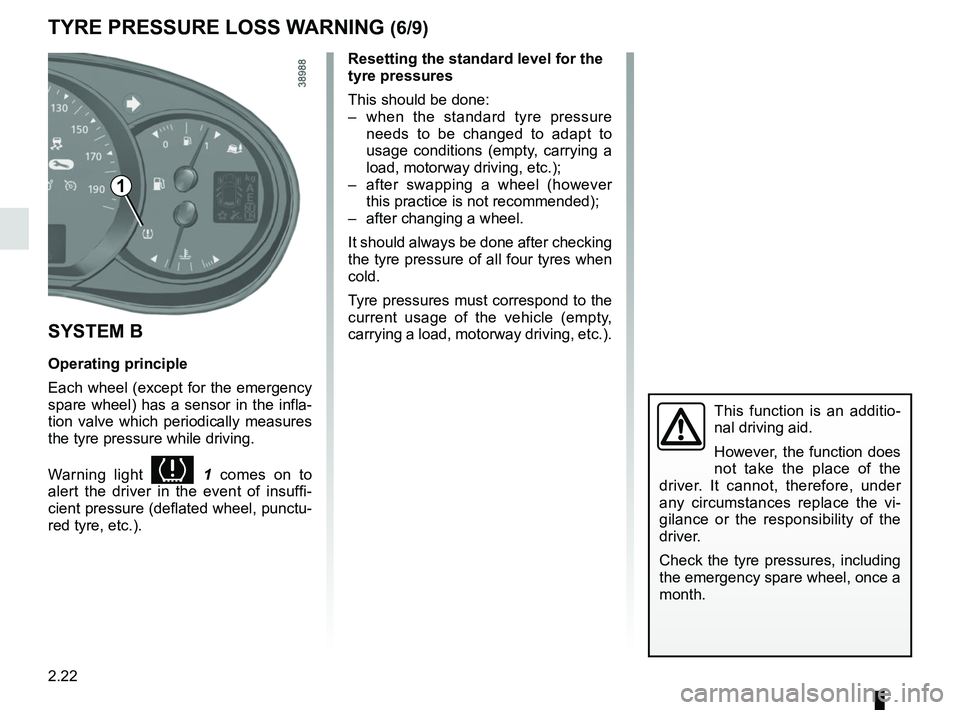
2.22
TYRE PRESSURE LOSS WARNING (6/9)
SYSTEM B
Operating principle
Each wheel (except for the emergency
spare wheel) has a sensor in the infla-
tion valve which periodically measures
the tyre pressure while driving.
Warning light
1 comes on to
alert the driver in the event of insuffi-
cient pressure (deflated wheel, punctu-
red tyre, etc.).
Resetting the standard level for the
tyre pressures
This should be done:
– when the standard tyre pressure needs to be changed to adapt to
usage conditions (empty, carrying a
load, motorway driving, etc.);
– after swapping a wheel (however this practice is not recommended);
– after changing a wheel.
It should always be done after checking
the tyre pressure of all four tyres when
cold.
Tyre pressures must correspond to the
current usage of the vehicle (empty,
carrying a load, motorway driving, etc.).
This function is an additio-
nal driving aid.
However, the function does
not take the place of the
driver. It cannot, therefore, under
any circumstances replace the vi-
gilance or the responsibility of the
driver.
Check the tyre pressures, including
the emergency spare wheel, once a
month.
1
Page 116 of 260
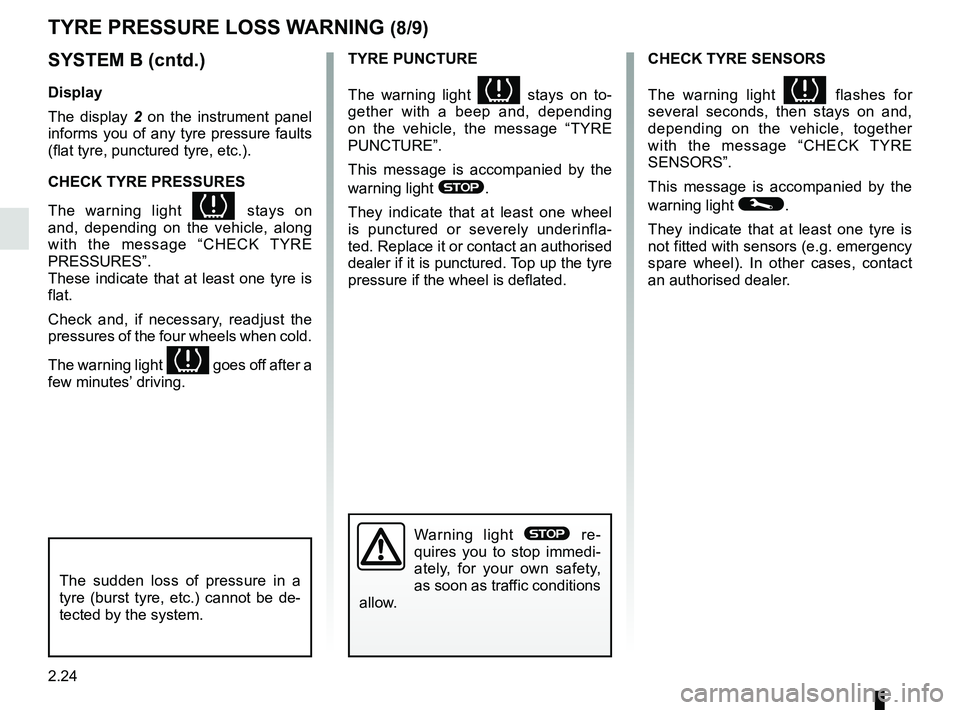
2.24
TYRE PRESSURE LOSS WARNING (8/9)
TYRE PUNCTURE
The warning light
stays on to-
gether with a beep and, depending
on the vehicle, the message “TYRE
PUNCTURE”.
This message is accompanied by the
warning light
®.
They indicate that at least one wheel
is punctured or severely underinfla-
ted. Replace it or contact an authorised
dealer if it is punctured. Top up the tyre
pressure if the wheel is deflated.
Warning light ® re-
quires you to stop immedi-
ately, for your own safety,
as soon as traffic conditions
allow.
The sudden loss of pressure in a
tyre (burst tyre, etc.) cannot be de-
tected by the system.
CHECK TYRE SENSORS
The warning light
flashes for
several seconds, then stays on and,
depending on the vehicle, together
with the message “CHECK TYRE
SENSORS”.
This message is accompanied by the
warning light
©.
They indicate that at least one tyre is
not fitted with sensors (e.g. emergency
spare wheel). In other cases, contact
an authorised dealer.
SYSTEM B (cntd.)
Display
The display 2 on the instrument panel
informs you of any tyre pressure faults
(flat tyre, punctured tyre, etc.).
CHECK TYRE PRESSURES
The warning light
stays on
and, depending on the vehicle, along
with the message “CHECK TYRE
PRESSURES”.
These indicate that at least one tyre is
flat.
Check and, if necessary, readjust the
pressures of the four wheels when cold.
The warning light
goes off after a
few minutes’ driving.
Page 117 of 260
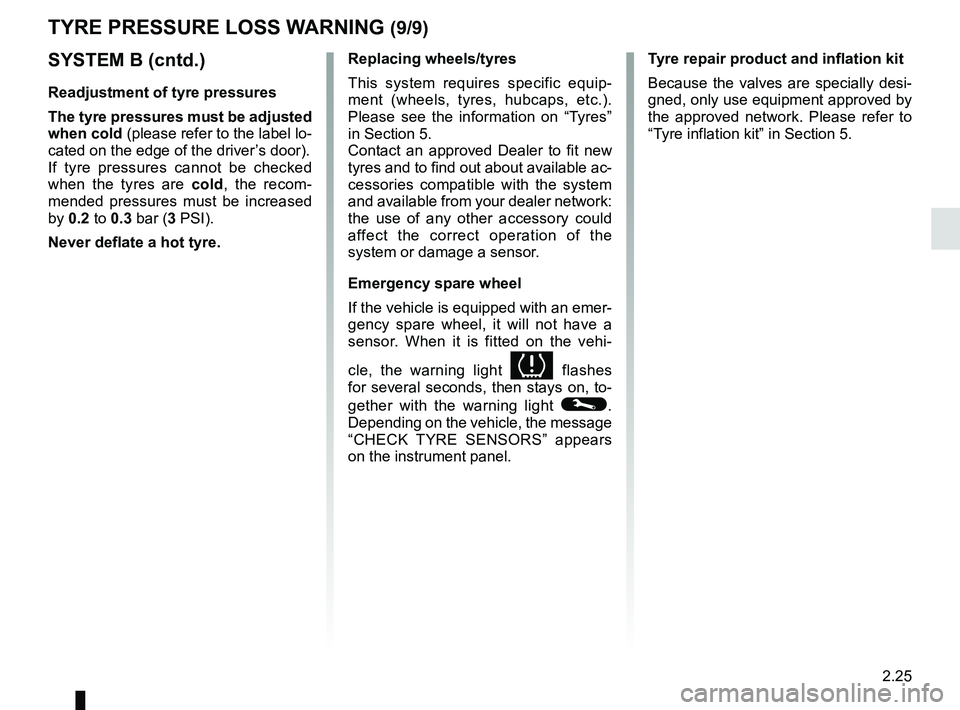
2.25
Replacing wheels/tyres
This system requires specific equip-
ment (wheels, tyres, hubcaps, etc.).
Please see the information on “Tyres”
in Section 5.
Contact an approved Dealer to fit new
tyres and to find out about available ac-
cessories compatible with the system
and available from your dealer network:
the use of any other accessory could
affect the correct operation of the
system or damage a sensor.
Emergency spare wheel
If the vehicle is equipped with an emer-
gency spare wheel, it will not have a
sensor. When it is fitted on the vehi-
cle, the warning light
flashes
for several seconds, then stays on, to-
gether with the warning light
©.
Depending on the vehicle, the message
“CHECK TYRE SENSORS” appears
on the instrument panel.
SYSTEM B (cntd.)
Readjustment of tyre pressures
The tyre pressures must be adjusted
when cold (please refer to the label lo-
cated on the edge of the driver’s door).
If tyre pressures cannot be checked
when the tyres are cold, the recom-
mended pressures must be increased
by 0.2 to 0.3 bar (3 PSI).
Never deflate a hot tyre.
TYRE PRESSURE LOSS WARNING (9/9)
Tyre repair product and inflation kit
Because the valves are specially desi-
gned, only use equipment approved by
the approved network. Please refer to
“Tyre inflation kit” in Section 5.
Page 119 of 260
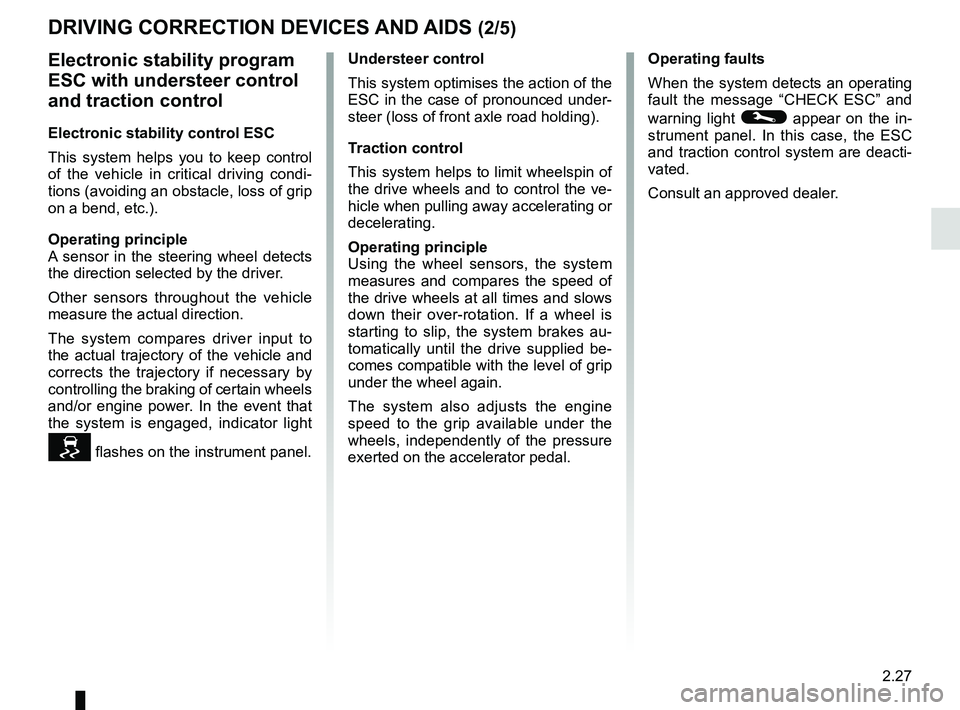
2.27
DRIVING CORRECTION DEVICES AND AIDS (2/5)
Electronic stability program
ESC with understeer control
and traction control
Electronic stability control ESC
This system helps you to keep control
of the vehicle in critical driving condi-
tions (avoiding an obstacle, loss of grip
on a bend, etc.).
Operating principle
A sensor in the steering wheel detects
the direction selected by the driver.
Other sensors throughout the vehicle
measure the actual direction.
The system compares driver input to
the actual trajectory of the vehicle and
corrects the trajectory if necessary by
controlling the braking of certain wheels
and/or engine power. In the event that
the system is engaged, indicator light
flashes on the instrument panel. Understeer control
This system optimises the action of the
ESC in the case of pronounced under-
steer (loss of front axle road holding).
Traction control
This system helps to limit wheelspin of
the drive wheels and to control the ve-
hicle when pulling away accelerating or
decelerating.
Operating principle
Using the wheel sensors, the system
measures and compares the speed of
the drive wheels at all times and slows
down their over-rotation. If a wheel is
starting to slip, the system brakes au-
tomatically until the drive supplied be-
comes compatible with the level of grip
under the wheel again.
The system also adjusts the engine
speed to the grip available under the
wheels, independently of the pressure
exerted on the accelerator pedal. Operating faults
When the system detects an operating
fault the message “CHECK ESC” and
warning light
© appear on the in-
strument panel. In this case, the ESC
and traction control system are deacti-
vated.
Consult an approved dealer.
Page 130 of 260
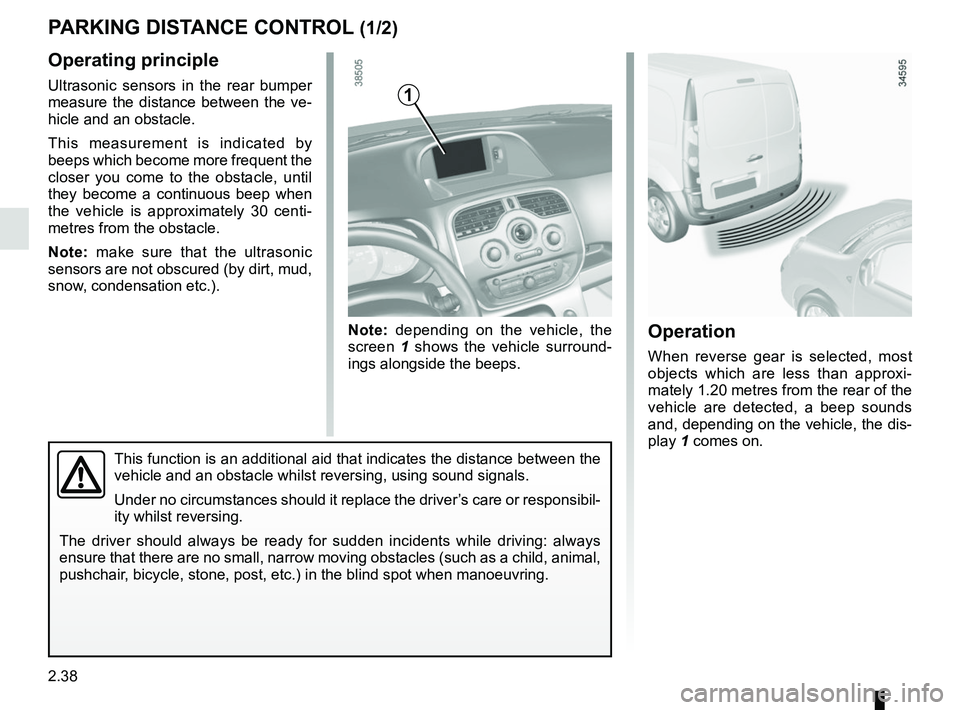
2.38
Operating principle
Ultrasonic sensors in the rear bumper
measure the distance between the ve-
hicle and an obstacle.
This measurement is indicated by
beeps which become more frequent the
closer you come to the obstacle, until
they become a continuous beep when
the vehicle is approximately 30 centi-
metres from the obstacle.
Note: make sure that the ultrasonic
sensors are not obscured (by dirt, mud,
snow, condensation etc.).
PARKING DISTANCE CONTROL (1/2)
Operation
When reverse gear is selected, most
objects which are less than approxi-
mately 1.20 metres from the rear of the
vehicle are detected, a beep sounds
and, depending on the vehicle, the dis-
play 1 comes on.
Note: depending on the vehicle, the
screen
1 shows the vehicle surround-
ings alongside the beeps.
This function is an additional aid that indicates the distance between t\
he
vehicle and an obstacle whilst reversing, using sound signals.
Under no circumstances should it replace the driver’s care or responsibil-
ity whilst reversing.
The driver should always be ready for sudden incidents while driving: al\
ways
ensure that there are no small, narrow moving obstacles (such as a chil\
d, animal,
pushchair, bicycle, stone, post, etc.) in the blind spot when manoeuvring.
1
Page 220 of 260
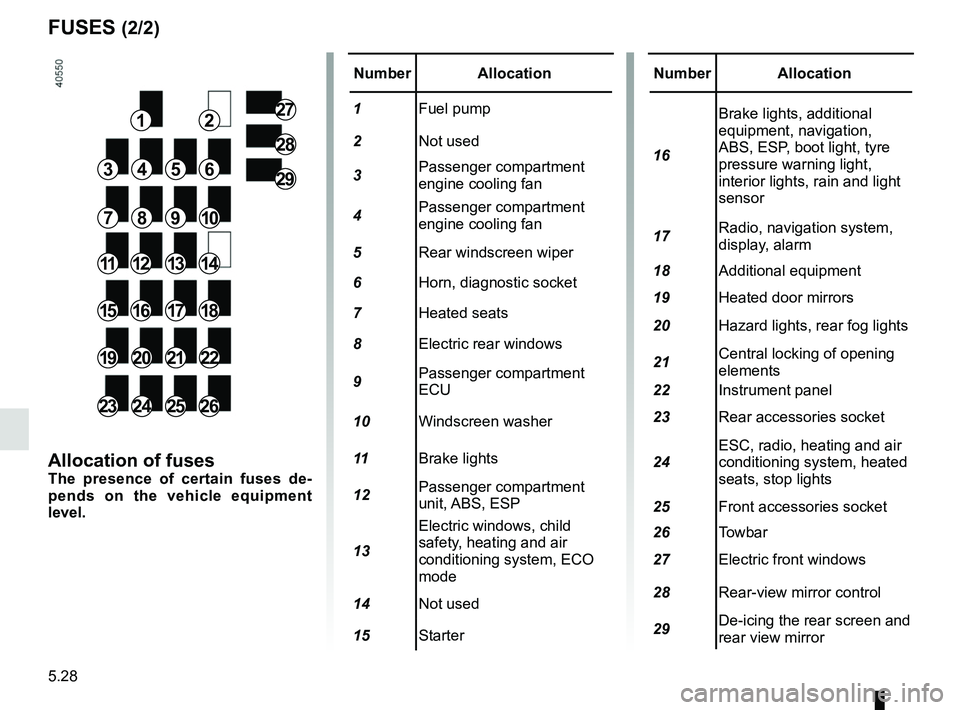
5.28
FUSES (2/2)
Number Allocation
1 Fuel pump
2 Not used
3 Passenger compartment
engine cooling fan
4 Passenger compartment
engine cooling fan
5 Rear windscreen wiper
6 Horn, diagnostic socket
7 Heated seats
8 Electric rear windows
9 Passenger compartment
ECU
10 Windscreen washer
11 Brake lights
12 Passenger compartment
unit, ABS, ESP
13 Electric windows, child
safety, heating and air
conditioning system, ECO
mode
14 Not used
15 StarterNumber Allocation
16 Brake lights, additional
equipment, navigation,
ABS, ESP, boot light, tyre
pressure warning light,
interior lights, rain and light
sensor
17 Radio, navigation system,
display, alarm
18 Additional equipment
19 Heated door mirrors
20 Hazard lights, rear fog lights
21 Central locking of opening
elements
22 Instrument panel
23 Rear accessories socket
24 ESC, radio, heating and air
conditioning system, heated
seats, stop lights
25 Front accessories socket
26 Towbar
27 Electric front windows
28 Rear-view mirror control
29 De-icing the rear screen and
rear view mirror
12
3456
78910
11121314
15161718
19202122
23242526
27
28
29
Allocation of fusesThe presence of certain fuses de-
pends on the vehicle equipment
level.
Page 256 of 260
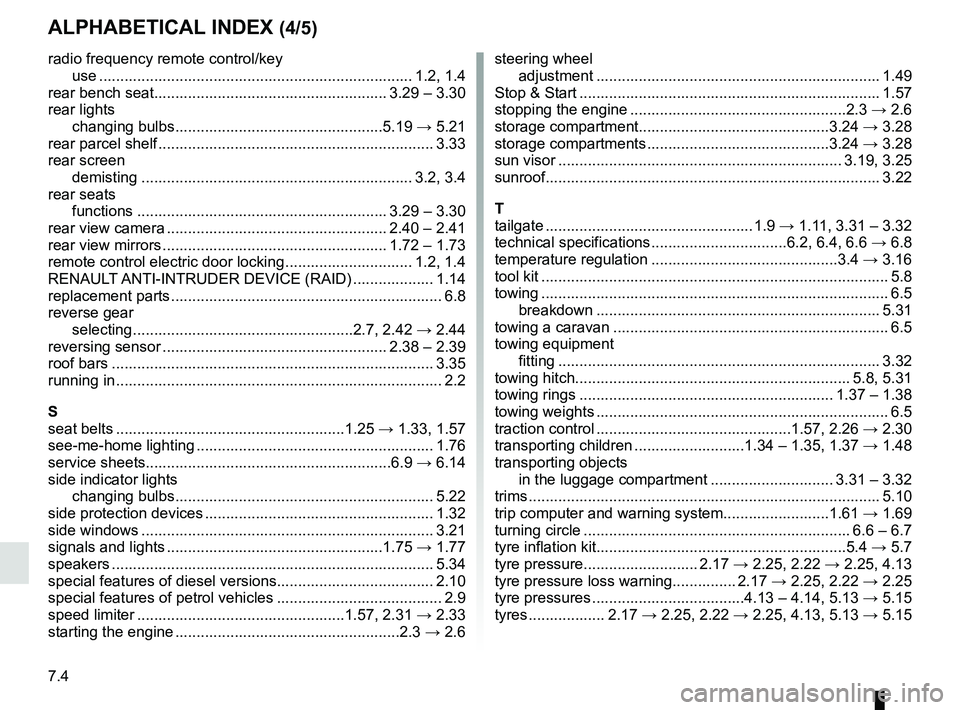
7.4
ALPHABETICAL INDEX (4/5)
radio frequency remote control/keyuse ....................................................................\
...... 1.2, 1.4
rear bench seat....................................................... 3.29 – 3.30
rear lights changing bulbs .................................................5.19 → 5.21
rear parcel shelf ................................................................. 3.33
rear screen demisting ..............................................................\
.. 3.2, 3.4
rear seats functions ........................................................... 3.29 – 3.30
rear view camera .................................................... 2.40 – 2.41
rear view mirrors ..................................................... 1.72 – 1.73
remote control electric door locking .............................. 1.2, 1.4
RENAULT ANTI-INTRUDER DEVICE (RAID) ................... 1.14
replacement parts ................................................................ 6.8
reverse gear selecting ....................................................2.7, 2.42 → 2.44
reversing sensor ..................................................... 2.38 – 2.39
roof bars ........................................................................\
.... 3.35
running in ........................................................................\
..... 2.2
S
seat belts ......................................................1.25 → 1.33, 1.57
see-me-home lighting ........................................................ 1.76
service sheets..........................................................6.9 → 6.14
side indicator lights changing bulbs ............................................................. 5.22
side protection devices ...................................................... 1.32
side windows ..................................................................... 3.21
signals and lights ...................................................1.75 → 1.77
speakers ...............................................................\
............. 5.34
special features of diesel versions..................................... 2.10
special features of petrol vehicles ....................................... 2.9
speed limiter .................................................1.57, 2.31 → 2.33
starting the engine .....................................................2.3 → 2.6steering wheel
adjustment .............................................................\
...... 1.49
Stop & Start ....................................................................... 1.57
stopping the engine ...................................................2.3 → 2.6
storage compartment.............................................3.24 → 3.28
storage compartments ...........................................3.24 → 3.28
sun visor ................................................................... 3.19, 3.25
sunroof........................................................................\
....... 3.22
T
tailgate ................................................. 1.9 → 1.11, 3.31 – 3.32
technical specifications ................................6.2, 6.4, 6.6 → 6.8
temperature regulation ............................................3.4 → 3.16
tool kit ........................................................................\
.......... 5.8
towing .................................................................\
................. 6.5 breakdown ..............................................................\
..... 5.31
towing a caravan ................................................................. 6.5
towing equipment fitting ................................................................\
............ 3.32
towing hitch................................................................. 5.8, 5.31
towing rings ............................................................ 1.37 – 1.38
towing weights ..................................................................... 6.5
traction control ..............................................1.57, 2.26 → 2.30
transporting children ..........................1.34 – 1.35, 1.37 → 1.48
transporting objects in the luggage compartment ............................. 3.31 – 3.32
trims ..................................................................\
................. 5.10
trip computer and warning system.........................1.61 → 1.69
turning circle ............................................................... 6.6 – 6.7
tyre inflation kit...........................................................5.4 → 5.7
tyre pressure........................... 2.17 → 2.25, 2.22 → 2.25, 4.13
tyre pressure loss warning............... 2.17 → 2.25, 2.22 → 2.25
tyre pressures ....................................4.13 – 4.14, 5.13 → 5.15
tyres .................. 2.17 → 2.25, 2.22 → 2.25, 4.13, 5.13 → 5.15